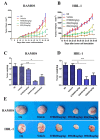A novel orally available Syk/Src/Jak2 inhibitor, SKLB-850, showed potent anti-tumor activities in B cell lymphoma (BCL) models
- PMID: 29340070
- PMCID: PMC5762338
- DOI: 10.18632/oncotarget.22847
A novel orally available Syk/Src/Jak2 inhibitor, SKLB-850, showed potent anti-tumor activities in B cell lymphoma (BCL) models
Abstract
B cell lymphoma (BCL) is the most frequently diagnosed type of non-Hodgkin lymphoma (NHL), and accounts for about 4% of all cancers in the USA. Kinases spleen tyrosine kinase (Syk), Src, and Janus kinase 2 (JAK2) have been thought as potential targets for the treatment of BCL. We have recently developed a multikinase inhibitor, SKLB-850, which potently inhibits Syk, Src, and JAK2. The aim of this study is to investigate the anti-BCL activities and mechanisms of action of SKLB-850 both in vitro and in vivo. Our results showed that SKLB-850 significantly inhibited BCL cell proliferation, and induced apoptosis of BCL cells. It could considerably decrease the secretion of chemokines CCL3, CCL4, and CXCL12. Oral administration of SKLB-850 considerably suppressed the tumor growth in BCL xenograft models (Ramos and HBL-1) in a dose-dependent manner. Immunohistochemistry of tumor tissues showed that SKLB-850 efficiently inhibited the activation of Syk/ERK, Src/FAK and JAK2/Stat3 pathways. Collectively, SKLB-850 could be a promising agent for the treatment of BCL, hence deserving further study.
Keywords: B cell lymphoma; SKLB-850; multikinase inhibitor.
Conflict of interest statement
CONFLICTS OF INTEREST No potential conflicts of interest were disclosed.
Figures







Similar articles
-
A preclinical evaluation of a novel multikinase inhibitor, SKLB-329, as a therapeutic agent against hepatocellular carcinoma.Int J Cancer. 2014 Dec 15;135(12):2972-83. doi: 10.1002/ijc.28944. Epub 2014 May 12. Int J Cancer. 2014. PMID: 24789676
-
Preclinical pharmacodynamic evaluation of drug candidate SKLB-178 in the treatment of non-small cell lung cancer.Oncotarget. 2017 Feb 21;8(8):12843-12854. doi: 10.18632/oncotarget.14597. Oncotarget. 2017. PMID: 28086226 Free PMC article.
-
SKLB-287, a novel oral multikinase inhibitor of EGFR and VEGFR2, exhibits potent antitumor activity in LoVo colorectal tumor model.Neoplasma. 2014;61(5):514-22. doi: 10.4149/neo_2014_063. Neoplasma. 2014. PMID: 25030434
-
Sesquiterpene dimmer (DSF-27) inhibits the release of neuroinflammatory mediators from microglia by targeting spleen tyrosine kinase (Syk) and Janus kinase 2 (Jak2): Two major non-receptor tyrosine signaling proteins involved in inflammatory events.Toxicol Appl Pharmacol. 2014 Mar 15;275(3):244-56. doi: 10.1016/j.taap.2014.01.014. Epub 2014 Jan 28. Toxicol Appl Pharmacol. 2014. PMID: 24486434
-
Cellular and molecular signal transduction pathways modulated by rituximab (rituxan, anti-CD20 mAb) in non-Hodgkin's lymphoma: implications in chemosensitization and therapeutic intervention.Oncogene. 2005 Mar 24;24(13):2121-43. doi: 10.1038/sj.onc.1208349. Oncogene. 2005. PMID: 15789036 Review.
Cited by
-
Crosstalk between CXCL12/CXCR4/ACKR3 and the STAT3 Pathway.Cells. 2024 Jun 13;13(12):1027. doi: 10.3390/cells13121027. Cells. 2024. PMID: 38920657 Free PMC article. Review.
-
Fostamatinib, a Spleen Tyrosine Kinase Inhibitor, Exerts Anti-Inflammatory Activity via Inhibiting STAT1/3 Signaling Pathways.J Inflamm Res. 2024 Nov 25;17:9757-9771. doi: 10.2147/JIR.S486753. eCollection 2024. J Inflamm Res. 2024. PMID: 39618932 Free PMC article.
-
Vortioxetine hydrobromide inhibits the growth of gastric cancer cells in vivo and in vitro by targeting JAK2 and SRC.Oncogenesis. 2023 May 5;12(1):24. doi: 10.1038/s41389-023-00472-4. Oncogenesis. 2023. PMID: 37147297 Free PMC article.
References
-
- Muller AM, Ihorst G, Mertelsmann R, Engelhardt M. Epidemiology of non-Hodgkin’s lymphoma (NHL): trends, geographic distribution, and etiology. Ann Hematol. 2005;84:1–12. https://doi.org/10.1007/s00277-004-0939-7. - DOI - PubMed
-
- Tuccori M, Focosi D, Blandizzi C, Pelosini M, Montagnani S, Maggi F, Pistello M, Antonioli L, Fornai M, Pepe P, Rossi G, Petrini M. Inclusion of rituximab in treatment protocols for non-Hodgkin’s lymphomas and risk for progressive multifocal leukoencephalopathy. Oncologist. 2010;15:1214–9. https://doi.org/10.1634/theoncologist.2010-0098. - DOI - PMC - PubMed
-
- Alinari L, Quinion C, Blum KA. Bruton’s tyrosine kinase inhibitors in B-cell non-Hodgkin’s lymphomas. Clin Pharmacol Ther. 2015;97:469–77. https://doi.org/10.1002/cpt.65. - DOI - PubMed
-
- Ram R, Ben-Bassat I, Shpilberg O, Polliack A, Raanani P. The late adverse events of rituximab therapy--rare but there! Leuk Lymphoma. 2009;50:1083–95. https://doi.org/10.1080/10428190902934944. - DOI - PubMed
LinkOut - more resources
Full Text Sources
Other Literature Sources
Research Materials
Miscellaneous

